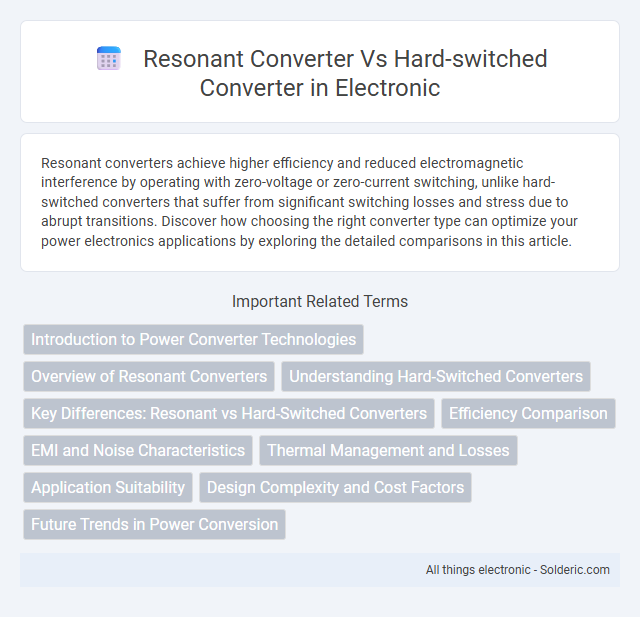Resonant converters achieve higher efficiency and reduced electromagnetic interference by operating with zero-voltage or zero-current switching, unlike hard-switched converters that suffer from significant switching losses and stress due to abrupt transitions. Discover how choosing the right converter type can optimize your power electronics applications by exploring the detailed comparisons in this article.
Comparison Table
| Aspect | Resonant Converter | Hard-Switched Converter |
|---|---|---|
| Switching Technique | Soft-switching (zero-voltage or zero-current switching) | Hard-switching (switches turn on/off under full voltage/current) |
| Efficiency | Higher due to reduced switching losses | Lower, more switching losses and heat generated |
| Electromagnetic Interference (EMI) | Lower EMI because of soft switching | Higher EMI due to abrupt switching transitions |
| Switching Frequency | Typically higher frequencies possible (hundreds of kHz to MHz) | Lower to moderate frequencies (tens to hundreds kHz) |
| Complexity | More complex design and control algorithms | Simple design, easier control |
| Thermal Management | Lower thermal stress on components | Higher thermal stress, requires robust cooling |
| Applications | High-efficiency power supplies, LED drivers, induction heating | General power conversion, cost-sensitive or simple applications |
Introduction to Power Converter Technologies
Resonant converters utilize soft-switching techniques that significantly reduce switching losses and electromagnetic interference compared to hard-switched converters, which operate with abrupt voltage and current transitions. These advantages make resonant converters highly efficient for high-frequency power conversion applications, such as in renewable energy systems and electric vehicles. Hard-switched converters remain prevalent for their simple design and cost-effectiveness in lower-frequency or less demanding environments.
Overview of Resonant Converters
Resonant converters utilize LC tank circuits to achieve zero-voltage or zero-current switching, significantly reducing switching losses and electromagnetic interference compared to hard-switched converters. These converters operate at resonant frequencies, enabling higher efficiency and improved thermal performance in power conversion applications. Their soft-switching characteristic allows for higher switching speeds and smaller passive components, optimizing overall circuit design.
Understanding Hard-Switched Converters
Hard-switched converters use conventional switching techniques where the power transistor switches fully on or off, resulting in significant switching losses and electromagnetic interference. These converters often experience higher thermal stress and reduced efficiency compared to resonant converters due to abrupt voltage and current transitions. Understanding hard-switched converters is essential for applications requiring simpler control strategies despite their lower efficiency and increased component stress.
Key Differences: Resonant vs Hard-Switched Converters
Resonant converters operate using zero-voltage or zero-current switching, which significantly reduces switching losses and electromagnetic interference compared to hard-switched converters that switch under full voltage and current stress. The soft-switching nature of resonant converters enhances efficiency and thermal performance, making them ideal for high-frequency applications, whereas hard-switched converters are simpler but suffer from increased switching losses and higher device stress. Resonant converters require more complex control and design due to their frequency-dependent operation, while hard-switched converters offer straightforward control at the expense of increased switching noise and reduced efficiency.
Efficiency Comparison
Resonant converters achieve higher efficiency than hard-switched converters by minimizing switching losses through soft-switching techniques like zero-voltage or zero-current switching. This reduction in switching stress enables operation at higher frequencies with less heat generation, improving overall power conversion efficiency. Hard-switched converters suffer from significant switching losses due to direct transistor switching under voltage or current, resulting in lower efficiency and increased thermal management requirements.
EMI and Noise Characteristics
Resonant converters generate significantly lower EMI and noise due to their soft-switching operation, which reduces voltage and current spikes during switching transitions. In contrast, hard-switched converters exhibit higher EMI emissions caused by abrupt switching events resulting in sharp voltage and current changes. Optimizing resonant converter designs can further minimize electromagnetic interference, enhancing overall system performance in sensitive electronic applications.
Thermal Management and Losses
Resonant converters significantly improve thermal management by operating with zero-voltage or zero-current switching, which drastically reduces switching losses and heat generation compared to hard-switched converters that endure high switching stresses. This efficient energy transfer lowers the thermal stress on components, enhancing reliability and enabling more compact cooling solutions. Your system benefits from improved efficiency and reduced thermal buildup, ensuring longer device lifespan and stable operation under high-power conditions.
Application Suitability
Resonant converters excel in high-frequency applications requiring efficient power conversion with reduced switching losses and minimal electromagnetic interference, making them ideal for data centers, electric vehicles, and renewable energy systems. Hard-switched converters suit simpler, lower-frequency applications where cost and design simplicity are prioritized over efficiency, such as consumer electronics and basic power supplies. Your choice depends on balancing efficiency and complexity against cost and application-specific demands.
Design Complexity and Cost Factors
Resonant converters feature more complex design requirements due to the need for precise control of switching frequency and load conditions, which often increases initial development time and engineering expertise. Hard-switched converters typically have simpler circuits and control schemes, resulting in lower upfront costs and simplified manufacturing processes. Your choice between these technologies should consider the trade-off between the sophisticated design and potentially higher efficiency of resonant converters versus the cost-effectiveness and ease of implementation of hard-switched converters.
Future Trends in Power Conversion
Resonant converters offer significant advantages over hard-switched converters by enabling higher efficiency and reduced electromagnetic interference, which are critical for future power conversion technologies. Innovations such as wide bandgap semiconductors and digital control algorithms are driving resonant converter adoption in renewable energy systems and electric vehicles. Your choice of converter topology will increasingly impact system performance, thermal management, and energy savings in next-generation power electronics.
resonant converter vs hard-switched converter Infographic

 solderic.com
solderic.com